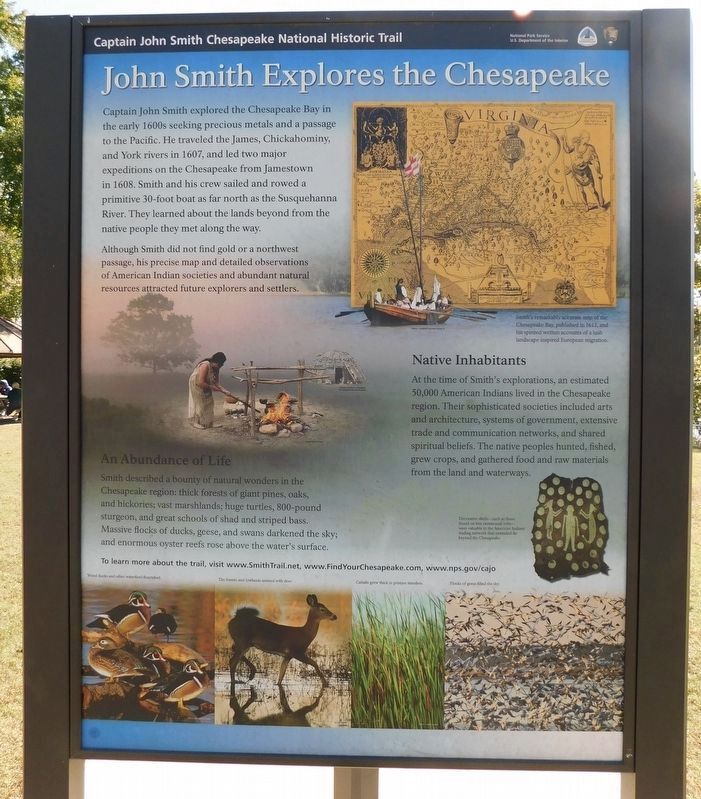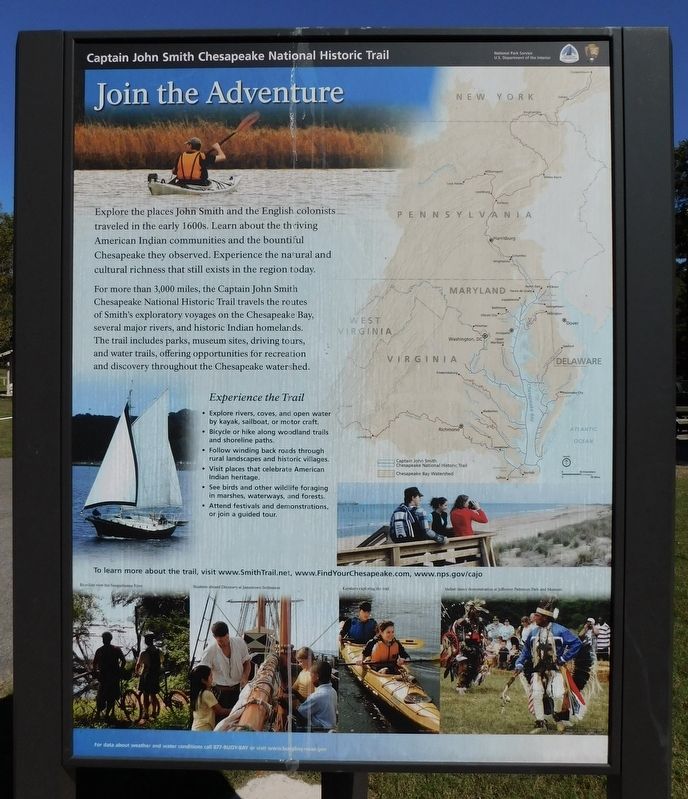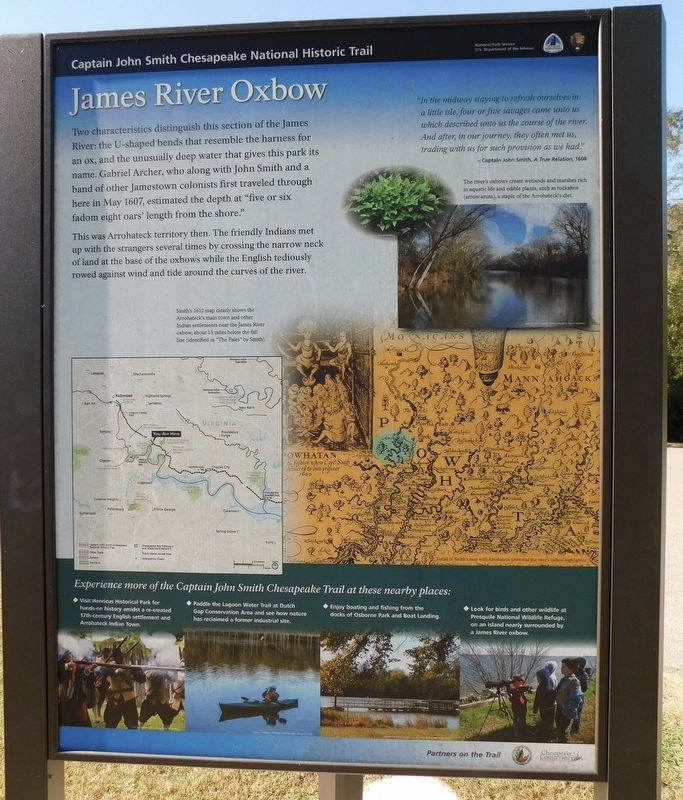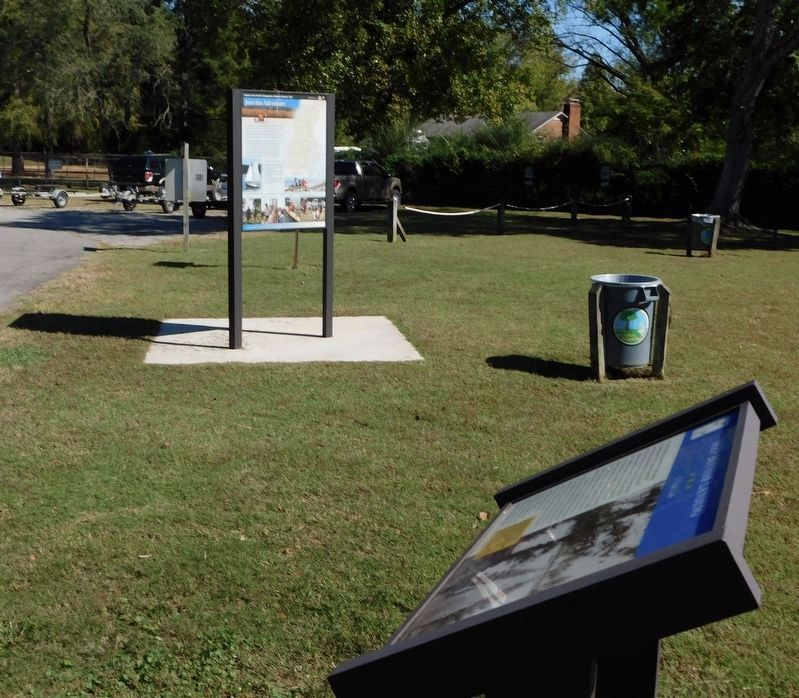Near Richmond in Henrico County, Virginia — The American South (Mid-Atlantic)
John Smith Explores the Chesapeake
Captain John Smith Chesapeake National Historic Trail
Inscription.
(panel 1)
John Smith Explores the Chesapeake
Captain John Smith explored the Chesapeake Bay in the early 1600s seeking precious metals and a passage to Asia. He traveled the James, Chickahominy, and York rivers in 1607, and led two major expeditions from Jamestown in 1608. Smith and his crew sailed and rowed a primitive 30-foot boat nearly 3,000 miles, reaching as far north as the Susquehanna River.
Although Smith did not discover gold, or a river passage to the Pacific, his precise map and detailed observations of American Indian societies and the abundant natural resources guided future explorers and settlers.
An Abundance of Life
Smith discovered a treasure trove of natural wonders in the Chesapeake region: thick forests of giant pines, oaks and hickories; vast marshlands; huge turtles, 800-pound sturgeon, and great schools of shad and striped bass. Massive flocks of ducks, geese, and swans darkened the sky; and enormous oyster reefs rose above the water's surface.
Native Inhabitants
At the time of Smith’s exploration, an estimated 50,000 American Indians dwelled in the Chesapeake region—as their ancestors had for thousands of years. Their sophisticated societies included arts and architecture, systems of government, extensive trade and communication networks, and shared spiritual beliefs. The native peoples hunted, fished, grew crops, and gathered food and raw materials from the land and waterways.
(captions)
(upper right) Smith’s remarkably accurate map of the Chesapeake Bay (published in 1612), and his spirited written accounts of a lush landscape inspired European migration.
(lower right) Decorative shells—such as those found on this ceremonial robe—were valuable in the American Indian's trading network that extended for hundreds of miles. This robe (which may have belonged to paramount chief Powhatan) was crafted from elk skins and adorned with more than 17,000 shells.
(panel 2)
Join the Adventure
Explore the places Englishman John Smith traveled in the early 1600s. Learn about the thriving American Indian communities he encountered and imagine the bountiful Chesapeake he observed. Experience the natural and cultural richness that exists in the region today.
The 3,000-mile Captain John Smith Chesapeake National Historic Trail traces the exploratory voyages Smith conducted from 1607 to 1609 on the Chesapeake Bay and along several major rivers. The trail includes parks, museum sites, driving tours, and water trails that align with Smith’s historic voyage routes and offer opportunities for recreation and discovery.
Experience the
Trail
• Explore rivers, coves, and open water by kayak, sailboat, or motor craft.
• Bicycle or hike along woodland trails and shoreline paths.
• Follow winding back roads through rural landscapes and historic villages.
• Visit places that celebrate American Indian heritage.
• See birds and other wildlife foraging in marshes, waterways, and forests.
• Attend festivals and demonstrations, or join a guided tour.
To learn more about the trail, visit www.SmithTrail.net, FindYourChesapeake.com, www.nps.gov/cajo
(captions)
Bicyclists view the Susquehanna River.; Students aboard Discovery at Jamestown Settlement; Kayakers explore the trail; Indian dance demonstration at Jefferson Patterson Park and Museum.
(panel 3)
James River Oxbow
Two characteristics distinguish this section of the James River: the U-shaped bends that resemble the harness for an ox, and the unusually deep water that gives this park its name. Gabriel Archer, who along with John Smith and a band of other Jamestown colonists first traveled through here in May 1607, estimated the depth at "five or six fadom eight oars' length from the shore."
This was Arrohateck territory then. The friendly Indians met up with the strangers several times by crossing the narrow neck of land at the base of the oxbows
while the English tediously rowed against wind and tide around the curves of the river.
"In the midway staying to refresh ourselves in a little isle, four or five savages came unto us which described unto us the course of the river. And after, in our journey, they often met us, trading with us for such provision as we had."
- Captain John Smith, A True Relation, 1608
Experience more of the Captain John Smith Chesapeake Trail at these nearby places:
• Visit Henricus Historical Park for hands-on history amidst a re-created 17th-century English settlement and Arrohateck Indian Town.
• Paddle the Lagoon Water Trail at Dutch Gap Conservation Area and see how nature has reclaimed a former industrial site.
• Enjoy boating and fishing from the docks of Osborne Park and Boat Landing.
• Look for birds and other wildlife at Presquile National Wildlife Refuge, on an island nearly surrounded by a James River oxbow.
(captions)
Smith's 1612 map clearly shows the Arrohateck's main town and other Indian settlements near the James River oxbow, about 13 miles below the fall line (identified as "The Fales" by Smith).
The river's oxbows create wetlands and marshes rich in aquatic life and edible plants, such as tuckahoe (arrow arum), a staple of the Arrohateck's diet.
Erected by
National Park Service, U.S. Department of the Interior.
Topics and series. This historical marker is listed in these topic lists: Colonial Era • Exploration • Native Americans • Waterways & Vessels. In addition, it is included in the Captain John Smith Chesapeake National Historic Trail series list. A significant historical year for this entry is 1607.
Location. 37° 24.446′ N, 77° 18.309′ W. Marker is near Richmond, Virginia, in Henrico County. Marker is on Deep Bottom Road, 0.3 miles east of James Street, on the left when traveling south. Marker is located at the James River in the Henrico County Park boat launch area in Deep Bottom Park. Touch for map. Marker is at or near this postal address: 9525 Deep Bottom Road, Henrico VA 23231, United States of America. Touch for directions.
Other nearby markers. At least 8 other markers are within 2 miles of this marker, measured as the crow flies. Deep Bottom Landing (a few steps from this marker); First Battle of Deep Bottom (approx. 0.9 miles away); Pleasants v. Pleasants (approx. 1.3 miles away); New Market Heights (approx. 1.3 miles away); New Market Road (approx. 1.4 miles away); a different marker also named New Market Heights (approx. 1˝ miles away); a different marker also named New Market Heights (approx. 1˝ miles away); Nathaniel Bacon (approx. 1˝ miles away). Touch for a list and map of all markers in Richmond.
Related marker. Click here for another marker that is related to this marker. Old Marker At This Location titled "Deep Bottom Park".
Credits. This page was last revised on November 28, 2021. It was originally submitted on November 25, 2021, by Bradley Owen of Morgantown, West Virginia. This page has been viewed 183 times since then and 48 times this year. Photos: 1, 2, 3, 4. submitted on November 26, 2021, by Bradley Owen of Morgantown, West Virginia. • Bernard Fisher was the editor who published this page.



